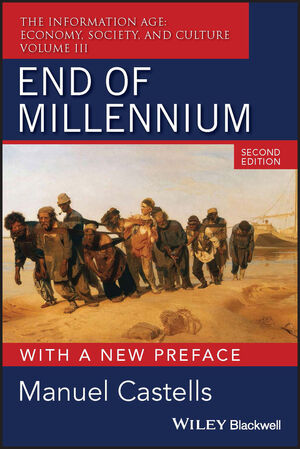End of Millennium, 2nd Edition, with a New PrefaceISBN: 978-1-4051-9688-8
Paperback
488 pages
March 2010, Wiley-Blackwell
 |
||||||
List of Figures.
List of Charts.
Preface to the 2010 Edition of End of Millennium.
Acknowledgments 1997.
A Time of Change.
1 The Crisis of Industrial Statism and the Collapse of the Soviet Union.
The Extensive Model of Economic Growth and the Limits of Hyperindustrialism.
The Technology Question.
The Abduction of Identity and the Crisis of Soviet Federalism.
The Last Perestroika.
Nationalism, Democracy, and the Disintegration of the Soviet State.
The Scars of History, the Lessons for Theory, the Legacy for Society.
2 The Rise of the Fourth World: Informational Capitalism, Poverty, and Social Exclusion.
Toward a Polarized World? A Global Overview.
The De-humanization of Africa.
Marginalization and selective integration of Sub-Saharan Africa in the informational-global economy.
Africa’s technological apartheid at the dawn of the Information Age.
The predatory state.
Zaıre: the personal appropriation of the state.
Nigeria: oil, ethnicity, and military predation.
Ethnic identity, economic globalization, and state formation in Africa.
Africa's plight.
Africa's hope? The South African connection.
Out of Africa or back to Africa? The politics and economics of self-reliance.
The New American Dilemma: Inequality, Urban Poverty, and Social Exclusion in the Information Age.
Dual America.
The inner-city ghetto as a system of social exclusion.
When the underclass goes to hell.
Globalization, Over-exploitation, and Social Exclusion: the View from the Children.
The sexual exploitation of children.
The killing of children: war massacres and child soldiers.
Why children are wasted.
Conclusion: the Black Holes of Informational Capitalism.
3 The Perverse Connection: the Global Criminal Economy.
Organizational Globalization of Crime, Cultural Identification of Criminals.
The Pillage of Russia.
The structural perspective.
Identifying the actors.
Mechanisms of Accumulation.
Narcotrafico, Development, and Dependency in Latin America.
What are the economic consequences of the drugs industry for Latin America?
Why Colombia?
The Impact of Global Crime on Economy, Politics, and Culture.
4 Development and Crisis in the Asian Pacific: Globalization and the State.
The Changing Fortunes of the Asian Pacific.
Heisei’s Japan: Developmental State versus Information Society.
A social model of the Japanese developmental process.
Declining sun: the crisis of the Japanese model of development.
The end of "Nagatacho politics".
Hatten Hokka and Johoka Shakai: a contradictory relationship.
Japan and the Pacific.
Beheading the Dragon? Four Asian Tigers with a Dragon Head, and their Civil Societies.
Understanding Asian development.
Singapore: state nation-building via multinational corporations.
South Korea: the state production of oligopolistic capitalism.
Taiwan: flexible capitalism under the guidance of an inflexible state.
Hong Kong model versus Hong Kong reality: small business in a world economy, and the colonial version of the welfare state.
The breeding of the tigers: commonalities and dissimilarities in their process of economic development.
The developmental state in East Asian industrialization: on the concept of the developmental state.
The rise of the developmental state: from the politics of survival to the process of nation-building.
The state and civil society in the restructuring of East Asia: how the developmental state succeeded in the development process.
Divergent paths: Asian "tigers" in the economic crisis.
Democracy, identity, and development in East Asia in the 1990s.
Chinese Developmental Nationalism with Socialist Characteristics.
The new Chinese revolution.
Guanxi capitalism? China in the global economy.
China's regional developmental states and the bureaucratic (capitalist) entrepreneurs.
Weathering the storm? China in the Asian economic crisis.
Democracy, development, and nationalism in the new China.
Conclusion: Globalization and the State.
5 The Unification of Europe: Globalization, Identity, and the Network State.
European Unification as a Sequence of Defensive Reactions: a Half-century Perspective.
Globalization and European Integration.
Cultural Identity and European Unification.
The Institutionalization of Europe: the Network State.
European Identity or European Project?
Conclusion: Making Sense of our World.
Genesis of a New World.
A New Society.
The New Avenues of Social Change.
Beyond this Millennium.
What is to be Done?
Finale.
Summary of Contents of Volumes I and II.
References.
Index.



